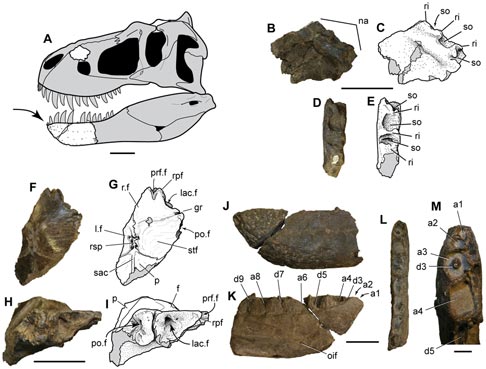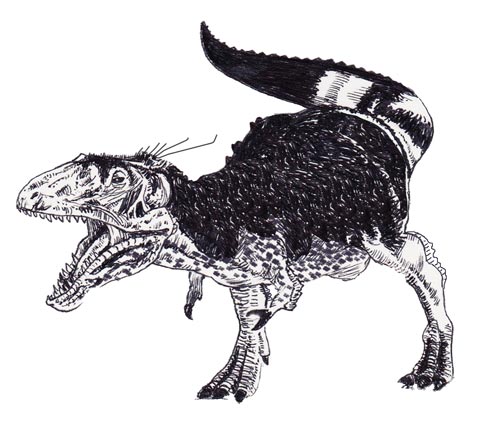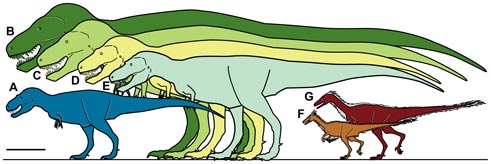Nanuqsaurus hoglundi – An update on “Polar Bear Lizard”
Nanuqsaurus hoglundi – Tyrannosaur from the High Arctic
Earlier this month, an academic paper was published on a newly discovered tyrannosaur which once roamed the very far north of an ancient Cretaceous strip of land called Laramidia. This new dinosaur might only be known from a few fragmentary fossils, fossils which were overlooked at the time they were first found back in 2006, but it is believed that this member of the tyrannosaurine may have been very closely related to T. rex.
Nanuqsaurus hoglundi
Named Nanuqsaurus hoglundi the fossils of this predatory dinosaur were found in a well-known horned dinosaur excavation site more than five hundred kilometres inside the Arctic Circle. The site is called Kikak-Tegoseak and it represents Upper Cretaceous deposits that form part of the extensive Prince Creek Formation in North Slope Borough, Alaska. The fossil material consists of three disarticulated pieces of skull including elements from the front of the jaw. These pieces were found in close proximity to each other and are believed to represent fragments from the same skeleton.
Comparison with Other Tyrannosaurs
Based on comparisons with better known tyrannosaurs, this dinosaur is believed to have been a “pygmy tyrannosaur”. It bucks the trend seen in tyrannosaurids known from the Maastrichtian faunal stage of the Cretaceous, when if anything, the tyrannosaurs roaming North America at the very end of the Cretaceous period tended to be bigger than their forebears from the Campanian faunal stage.
The Fossil Material Discovered to Date – Nanuqsaurus hoglundi
Picture credit: PLOS One
Diagram A indicates where on the tyrannosaur skull the three pieces of fossil would be located. The actual shape of the skull is based on more complete specimens. The research team led by Dr Anthony Fiorillo and Dr Ronald Tykoski of the Perot Museum of Nature and Science in Dallas, Texas came across the fossils in 2006 when trying to locate more material related to a horned dinosaur, one that would turn out to be a new species of Pachyrhinosaurus (P. perotorum).
It was only later, back in the preparation laboratory that the scientists realised the importance of their discovery.
To read more about the discovery of the third species of pachyrhinosaur: New Species of Polar Horned Dinosaur is Announced.
The Tyrannosaur Family Tree
This latest edition to the tyrannosaur family tree, measured around six metres in length. It was approximately half the size of its more illustrious cousin from the south, Tyrannosaurus rex. The name Nanuqsaurus hoglundi is derived from the local dialect for Polar Bear, a reference to the fact that as far as any one knows, this dinosaur was the apex predator in the environment. The specific or trivial name honours Forrest Hoglund in recognition of his career in the Earth Sciences and his work to help fund the Perot Museum.
A team member from Everything Dinosaur commented:
“Although this part of the world was not as cold back in the Late Cretaceous as it is now, Nanuqsaurus lived in a high-latitude continental environment with seasonal extremes. It may have been covered in a thick, coat of shaggy feathers, helping to insulate this dinosaur from the worst of the winter weather.”
The team member went onto state:
“For a significant amount of the year, the sun would not have risen above the horizon, its world would have been a very dark place, which explains why analysis of the skull material discovered to date suggests that this predator had a powerful sense of smell. Helpful when you live in a world of almost perpetual twilight for much of the year.”
Everything Dinosaur’s Illustration of Nanuqsaurus hoglundi
Picture credit: Everything Dinosaur
The academic paper’s authors have suggested the smaller body mass of Nanuqsaurus hoglundi compared to other Late Cretaceous tyrannosaurs may reflect an adaptation to the fluctuating amount of food resources available in its Arctic environment. In the summer, when daylight was almost constant, it is likely that large numbers of herbivorous dinosaurs migrated northwards up Laramidia to take advantage of the huge amounts of plant food available.
For models and replicas of members of the Tyrannosauroidea: CollectA Age of Dinosaurs Popular Models.
As the days grew shorter, the carnivores had much slimmer pickings as many prey animals probably moved out of the area. Of course, this is just speculation, this tyrannosaur may have migrated northwards from lower latitudes following the herds of herbivores.
The diversification of the Dinosauria in this part of the Americas at the end of the Cretaceous may stem from the partial isolation of the very northernmost parts of Laramidia with the pushing up of a mountain range (the Brooks Range), which may have cut-off part of the north of Laramidia during the Late Campanian faunal stage.
A Comparison of Nanuqsaurus hoglundi with other Tyrannosaurs
Picture credit: PLOS One
The diagram above compares N. hoglundi with T. rex (B – Sue from the Field Museum), a second Tyrannosaurus rex from the American Museum of Natural History (gracile form) – (C). Other theropods depicted include Daspletosaurus torosus (D) and Albertosaurus sarcophagus (E).
The other two theropods featured in the diagram above are not tyrannosaurs. The discovery of a “pygmy tyrannosaur” has intrigued a number of palaeontologists who are trying to build up a detailed picture of the fauna at the “top of the world” during the Late Cretaceous. Back in 2008, Dr Fiorillo discovered some super-sized troodontid teeth from the Colville River area. The Alaskan fossils represented animals that were 1.5 times bigger than the Troodons known from more southerly latitudes. In the diagram, Troodon formosus is represented by (F), the much large Troodon species from Alaska is (G).
In the diagram the scale bar equals 1 metre.
Why should we have much larger Troodon type predators yet evidence of a “pygmy” tyrannosaur living in the same environment? A number of theories have been proposed. Perhaps the proportionately larger eyes of the troodontids enabled them them to hunt larger prey than their southern cousins which did not have the predatory advantage of all that darkness.




